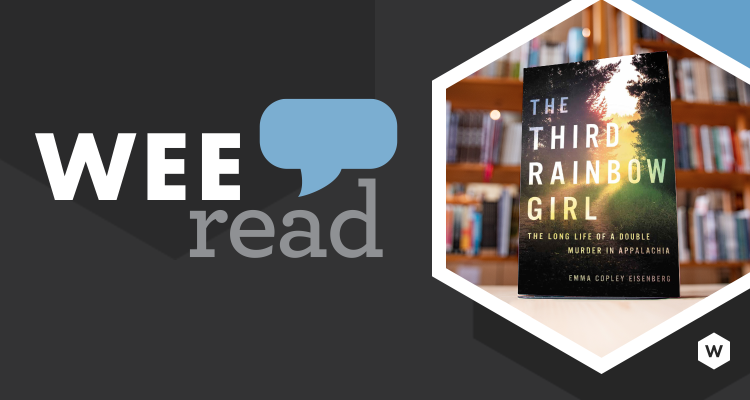West Virginia’s history is often not well represented in books that tell stories from our hills and valleys. In The Third Rainbow Girl: The Long Life of a Double Murder in Appalachia, Emma Copley Eisenberg bucks that stereotypical trend in her pursuit of truth in a 1980 murder case that shook the quiet communities of Pocahontas County. Part memoir, part biography and part murder mystery, Einsenberg’s work reveals more questions than answers, which keeps readers enthralled throughout the well-written narrative.
Spurred by stories she heard during her service work in the region, Eisenberg becomes entranced with the murders of Vicki Durian, 26, and Nancy Santomero, 19. They had been hitchhiking from Arizona to the Rainbow Gathering held in the Monongahela National Forest in West Virginia. Rainbow Gatherings first began in 1972 when the Rainbow Family of Living Light invited others who believe in peace, freedom and harmony to gather together for a week of fellowship at Colorado’s Strawberry Lake. More than 20,000 people showed up for this non-denominational camping retreat inspired by 1960s counterculture movements that shunned capitalism and mass media in favor of world peace and decentralization of leadership.
As Einsenberg tells us, Durian and Santomero’s bodies were found on June 25, 1980, not far from the festival’s location in the Monongahela National Forest. Both women had been shot at close range and had been left in a clearing in an isolated part of the county. Elizabeth Johndrow, the third Rainbow Girl referred to in the title, headed home the day before her friends were murdered. It becomes clear as the book progresses that Einsenberg herself becomes a kind of third Rainbow Girl as her own story of living and working in the area becomes intertwined with Durian, Santomero and Johndrow’s.
Not only are readers given a solid introduction to state cultural history, they are shown the ways in which national notions about Appalachia have created and sustained disparities throughout West Virginia, especially in rural counties with limited employment opportunities, inadequate access to high quality education and antiquated gender roles. Unlike other writers who have attempted to construct a knowable past for the state, Einsenberg never belittles West Virginians. Even though she is an outsider looking in, she works diligently at revealing the true complexities of the state’s history and the people who made it.
Eisenberg interviews many detectives, reporters and others involved in the case over the decades that it has been investigated. Her research took her around the country and uncovered the tangled tale of the still-unsolved murders. Along the way she encounters locals who were charged in the killings and then had charges dismissed, a farmer who was convicted for the crimes and then released, and a national serial killer who confessed to the murders. In the end, Eisenberg shares her conclusions, but in no way insists that she has all of the answers to what happened to these women more than 40 years ago.
Although the details Eisenberg presents about the murders are, for the most part, known to anyone who has followed the case with any kind of dedication, it is her critical examination of the circumstances surrounding the case that make it a provocative read. She forces readers to look carefully at the misogynistic culture in which these women lived and died, and how the way they looked played a role in the amount and kind of attention paid to their case.
Eisenberg’s book is not a warning for women traveling alone or a coming-of-age in Appalachian tale, though both of those concepts are explored herein. Instead, she makes us look again at the time and place in which these women were murdered and helps us understand why Durian and Santomero, and scores of other women, will likely never receive the justice they deserve.
• Christina Fisanick, Ph.D., is an associate professor of English at California University of Pennsylvania, where she teaches expository writing, creative non-fiction and digital storytelling. She is the author of more than 30 books, including her most recent memoir, “The Optimistic Food Addict: Recovering from Binge Eating Disorder” and and Digital Storytelling as Public History: A Guidebook for Educators with Robert Stakeley (forthcoming 2020). She has been a Weelunk contributing writer since 2015. Christina is a 1996 graduate of West Liberty University and a member of Ohio Valley Writers. She lives in Wheeling with her family.


